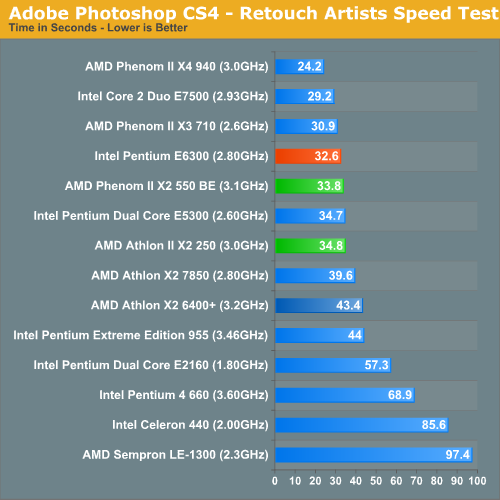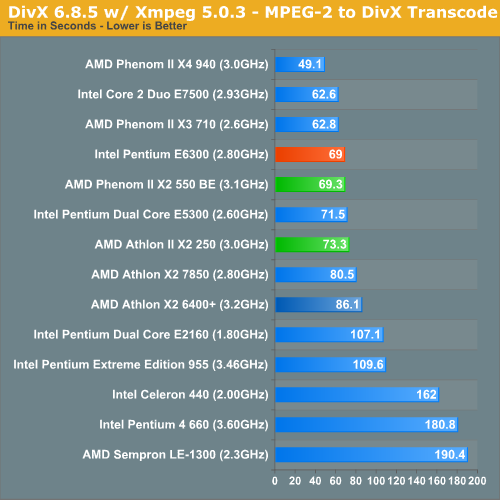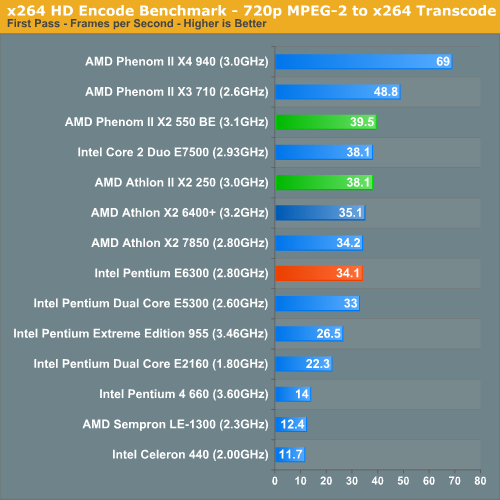The Athlon II X2 & Phenom II X2: 45nm Dual-Core from AMD
by Anand Lal Shimpi on June 2, 2009 12:00 AM EST- Posted in
- CPUs
Adobe Photoshop CS4 Performance
To measure performance under Photoshop CS4 we turn to the Retouch Artists’ Speed Test. The test does basic photo editing; there are a couple of color space conversions, many layer creations, color curve adjustment, image and canvas size adjustment, unsharp mask, and finally a gaussian blur performed on the entire image.
The whole process is timed and thanks to the use of Intel's X25-M SSD as our test bed hard drive, performance is far more predictable than back when we used to test on mechanical disks.
Time is reported in seconds and the lower numbers mean better performance. The test is multithreaded and can hit all four cores in a quad-core machine.

The Pentium E6300 pulls ahead in our CS4 benchmark; it's faster than both the Phenom II 550 and the Athlon II 250. Note the significant increase in performance from the Athlon X2 7850 to the Athlon II X2 250. All of the benefits of the Phenom II architecture are wrapped into the new Athlon II.
DivX 8.5.3 with Xmpeg 5.0.3
Our DivX test is the same DivX / XMpeg 5.03 test we've run for the past few years now, the 1080p source file is encoded using the unconstrained DivX profile, quality/performance is set balanced at 5 and enhanced multithreading is enabled:

DivX performance is very close between all three contenders. The E6300 and Phenom II 550 are virtually tied while the Athlon II 250 isn't far behind. For faster performance in encoding you need more cores though.
The Pentium EE 955, at one time an encoding monster, is now as fast as a Pentium E2160 in our DivX test.
x264 HD Video Encoding Performance
Graysky's x264 HD test uses the publicly available x264 codec (open source alternative to H.264) to encode a 4Mbps 720p MPEG-2 source. The focus here is on quality rather than speed, thus the benchmark uses a 2-pass encode and reports the average frame rate in each pass.

The latest version of the x264 codec fixes the problem exemplified in our first pass results, but these are still interesting to look at. Because of a number of unaligned memory loads all of Intel's pre-Nehalem Core based processors are penalized. The result is both the Athlon II and Phenom II are ahead of the E6300 here.
In the second pass of the test however, things return to "normal". The E6300 is technically in between the two new AMD dual-core chips, but all three basically perform the same. The Phenom II X3 710 adds another 40% to the processor cost and yields an extra ~20% in performance.

Windows Media Encoder 9 x64 Advanced Profile
In order to be codec agnostic we've got a Windows Media Encoder benchmark looking at the same sort of thing we've been doing in the DivX and x264 tests, but using WME instead.

Under WME, both of the AMD chips are a bit faster than the E6300. Note that even the triple-core Phenom II 710 is slower than the Phenom II X2 550; not all applications work well with AMD's odd 3-core configuration.










55 Comments
View All Comments
Gary Key - Tuesday, June 2, 2009 - link
The X2 6400+ is in the charts now and you can always use our Bench tool to compare a whole litany of processors against each other. AMD is currently phasing out of 90nm production and even several 65nm products will be phased out this year as they ramp the 45nm production.Spoelie - Thursday, June 4, 2009 - link
WOW, it really amazes me how little performance has improved. Athlon II X2 750 (3ghz) is barely faster in most benchmarks than a Athlon X2 6400+ (3,2ghz), and loses in 1 or 2.So the phenom core redesign buys around 300mhz around 3ghz, or only 10%. Everything else that improved in phenom is uncore.
And this while the original is at 90nm and the new one is 45nm, what a waste of potential. It seems to me AMD could've tried a little harder with the Athlon II.
Spoelie - Tuesday, June 2, 2009 - link
There's a small util/service out there that brings phenom II cnq behaviour from vista over to windows xp (phenom II's cnq behaves like phenom I's cnq under windows xp). It does this by disabling standard cnq (set power management not on "minimal") and implementing pstate changing itselfhttp://home.comcast.net/~pmc650/site/?/page/CNQ_Ph...">http://home.comcast.net/~pmc650/site/?/page/CNQ_Ph...
Maybe it can do the same for the Athlon II X2 on vista...
mohindar - Tuesday, June 2, 2009 - link
Hello Anand,It will be very nice to provide some benches regarding desktop virtualization, like how windows-xp usage on this chip and so on...
plonk420 - Tuesday, June 2, 2009 - link
i'm curious to see this on the bench!mapesdhs - Tuesday, June 2, 2009 - link
I'm beginning to wonder whether AMD/Intel are making the same mistake
we saw last year with gfx cards, ie. too many different options. What
is the target market for the new AMD CPUs? Many retailers seem to
offer just a small selection.
Any chance you could add an i7 920 and a 6000+ to the tables please?
The former for completeness, the latter to show how the newer AMD
parts stack up against a typical older product. I'd been hoping for
a suitable replacement for the 6000+ in my ASUS board, but still nothing (no BIOS support).
Atm it looks like my next system will be an i7 920 setup (core task
is video encoding). In the past there's been lots of talk about the
higher cost of an i7 system, but looking around yesterday, I was
surprised at how small the difference has now become. The i7 920 is
only 18% more than the Ph2 955 BE. Expecting a larger difference for
the mbd cost, I found an X58 board from Gigabyte (the GA-EX58-UD3R,
135 UKP from LambdaTek) right in the middle of the price range of
typical AM3 boards. They both use DDR3, so that isn't a factor. I
was going to build a Ph2 955 BE system for my brother as his next
gaming rig, but with such small price differences now in play, the
i7 looks more sensible.
Oh, a typo on the first page perhaps? Surely it should be 2 cores for
the Athlon64 X2?
Ian.
smilingcrow - Tuesday, June 2, 2009 - link
Judging by other reviews your choice of using the x264 HD Bench Pass 1 for the Power Consumption comparison doesn’t give a true representation of the situation.As expected other reviews shows the Athlon II X2 having a noticeably lower power consumption under typical loads.
The Phenom II X2 has too much extra circuitry to have lower power consumption and I’m surprised that you didn’t deduce that something was amiss.
Anand Lal Shimpi - Tuesday, June 2, 2009 - link
As I mentioned on the power consumption page, I'm guessing it has more to do with the current level of BIOS support for the Athlon II's power management. AMD is expecting a much better situation in the coming weeks.Take care,
Anand
Eeqmcsq - Tuesday, June 2, 2009 - link
The one comparing various Athlon X2 specs. The table says the Athlon 64 X2 has 4 cores.Anand Lal Shimpi - Tuesday, June 2, 2009 - link
Woops, thank you :)-A